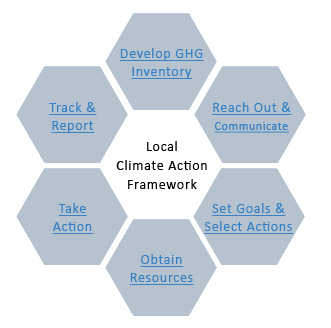Local Climate Action Framework: A Step-by-Step Implementation Guide
Below is a step-by-step guide to help local governments plan, implement, and evaluate climate, energy, and sustainability projects and programs.
Click on any of the six implementation phases in the graphic below to access guidance and resources. If you are designing a new program from scratch, you may want to start with the Develop GHG Inventory phase and explore subsequent phases in clockwise order.

Note that you do not need to complete the phases in order. The phases are highly interrelated, resulting in multiple entry points into and paths through the process. Specific connections among phases are highlighted throughout the implementation guide.
Develop GHG Inventory
This phase will help you to quantify greenhouse gas (GHG) emissions from local government operations or your community as a whole, including establishing a baseline inventory.
Reach Out & Communicate
This phase will help you to communicate with and engage partners and the community before, during, and after project implementation.
Set Goals & Select Actions
This phase will help you to articulate goals for your project or program and to identify, analyze, and select actions that promote those goals.
Obtain Resources
This phase will help you to identify and pursue the resources needed to support your project or program, including funding, staff time, technical expertise, and buy-in.
Take Action
This phase will help you to design and implement the actions selected in the Set Goals & Select Actions phase. It provides information on three types of efforts: to promote green government operations, adopt a policy, and engage the community.
Track & Report
This phase will help you to develop, track, analyze, and report on performance indicators to assess and share project progress and success.
This implementation guide is intended for small and mid-size communities with both beginner- and intermediate-level experience. The principles, information, and resources may also be relevant for larger communities or states embarking on similar projects. The guide is designed to help communities implement projects and programs that reduce greenhouse gas emissions, adapt to the impacts of climate change, and promote sustainability and resilience. These efforts can generate multiple economic, public health, and environmental benefits.
To learn how state governments can work with local governments to implement climate change and clean energy initiatives, visit the Assisting Local Governments page under State Activities.
For information about specific types of climate mitigation and adaptation options, visit the Topics section of the website.
